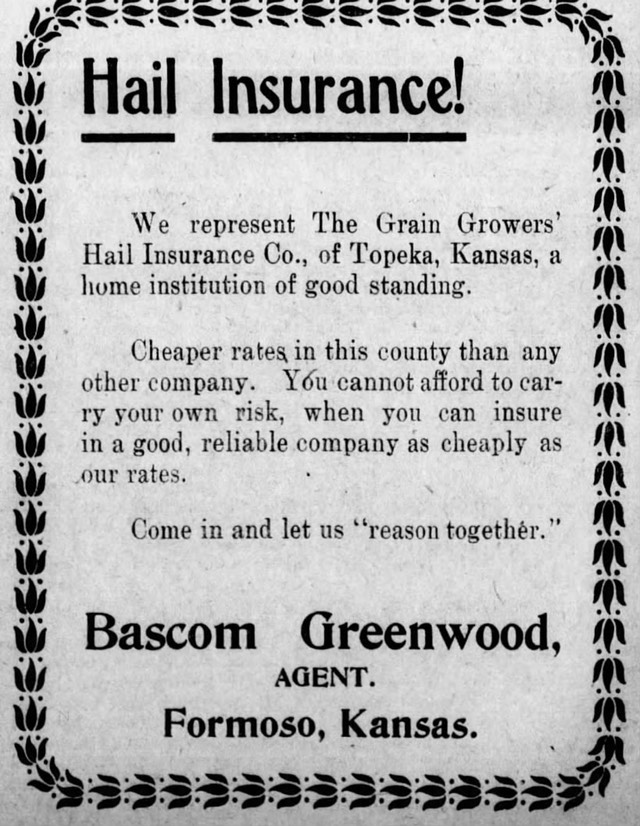I’ve known about the unhappy story of Peter Johnson and his wife Alice May Johnson since 1986 when my wife and I began typing my mother’s handwritten manuscript for her book about Formoso, the little Kansas town where she resided for more than eighty years.
Next to a massive train derailment that took out the local grain elevator in 1966, the Peter Johnson saga was probably the biggest news story ever to focus public attention on Formoso. The derailment was spectacular enough that footage of it was shown on the Huntley-Brinkley report on NBC, and probably the competing national networks as well. We watched Huntley & Brinkley because the NBC signal out of Hastings, Nebraska, was easier to tune in.
However, the derailment was a big story for only a day or two, while the Johnson family saga, as they say in journalism, had legs. The derailment was caused by a mechanical malfunction plus topography. The elevation at Mankato is 250 feet higher than at Formoso, which lies 12 miles down the tracks. Thus when 64 stationary freight cars slowly rolled away into the October night, invisibly gathering momentum mile after mile in the dark, the runaway cars were clattering along the rails so fast by the time they reached the curve heading into Formoso, that several cars jumped the tracks and landed in a tangled heap.
The 1907 episode, on the other hand, was the stuff of Greek tragedy, although I suppose both events might be described as train wrecks.
I always knew there had to be more to the Johnson story and finally decided to investigate, now that so much information is available at the click of a mouse. On a mundane note, I hadn’t known before that Alice May Greenwood was Peter Johnson’s second wife, nor that his first name wasn’t Peter, but Rasmus. I was also unaware that Mrs. Johnson’s father was named Napoleon Bonaparte Greenwood, although there’s disagreement about the status of the silent “e” at end of his middle name. It’s usually omitted in family records, but spell-check raised such a fuss that I let it ride.
While on the subject of names, the sixth child born to the Greenwoods was Clyde Euphrates Greenwood. I’m not sure what his father was thinking, although all three names do happen to be names of rivers. The Clyde is in Scotland, the Euphrates flows through Syria and Iraq, and there is a Greenwood River in Minnesota. That last one was formerly known as the Diarrhea River, apparently named to remind outdoorsmen to bring their own supply of drinking water.

The youngest of the couple’s children was Bascom Greenwood, born in 1885. He was a fixture on Formoso’s Main Street for many years, a businessman fondly remembered long after his passing in 1950. Bascom came to a doleful end, but one with an amusing coda, thanks to a gullible newspaper editor. Or at least, that’s the story.
One day Bascom noticed a small bump on his forehead that hadn’t been there before. In time he thought it seemed to be growing. and asked the doctor at Mankato to take a look. After being sent for tests at a nearby hospital the news was bleak. A rare form of malignancy had penetrated his skull and was already invading cerebral tissue. In that era the tumor was considered inoperable.
Undaunted, Bascom began to experiment, daubing the visible part of the tumor with various ointments, eventually settling on a daily regimen of vigorous massages with wool fat lotion. Soon he began to see a slight difference, and after a few weeks felt certain that the bump on his forehead was shrinking day by day.
Elated, he dropped by the newspaper office to share the happy turn of events with the paper’s editor, who was always delighted to chat with subscribers while scribbling animatedly on his notepad, ever on the hunt for newsworthy items.
Evidently the typesetter decided that the resulting news-note that was handed to him deserved a headline, and distilled one from the body of the text. So, one story on that week’s front page was said to have been introduced with a startling revelation:
Bascom Greenwood Discovers Cure for Cancer
Of course what had really happened was that the tumor invading Bascom’s brain had caused his mind to begin playing tricks on him. The bump had not diminished at all and Bascom would succumb to the cancer in due course.
I first heard that story sixty years ago. Unfortunately I must admit to hearing it from a relative with a fondness for exaggeration, and have found no corroborating evidence. I still like it.
John Peter Johnson, the little boy who survived his mother’s nightmarish attack, remained in the Formoso area where he wed Zoa Higbee, a lady who sometimes dropped by my Aunt Vera’s house with her guitar.
Although his older sister Dorothy also survived the incident, she would die much too young. After she married Frank Gale the couple moved to Chicago where their son William was born in 1921. Almost a decade later she died of undisclosed causes at the age of 34, which had also been her mother’s age at death. Her only child was left motherless at the age of 9, the same age Dorothy had been when she lost her own mother in 1907. William would be sent to live with his Uncle John and Aunt Zoa at Formoso.
There is a cute coincidence that may be worth mentioning about Dorothy’s move to Chicago, which in 1893 had been home to the World Columbian Exposition, where the spectacular White City inspired L. Frank Baum to invent a green one for his books about the Land of Oz.
And so it was that an orphaned farm girl left the parched Kansas prairie behind her, to seek her destiny in the Windy City as Dorothy Gale.